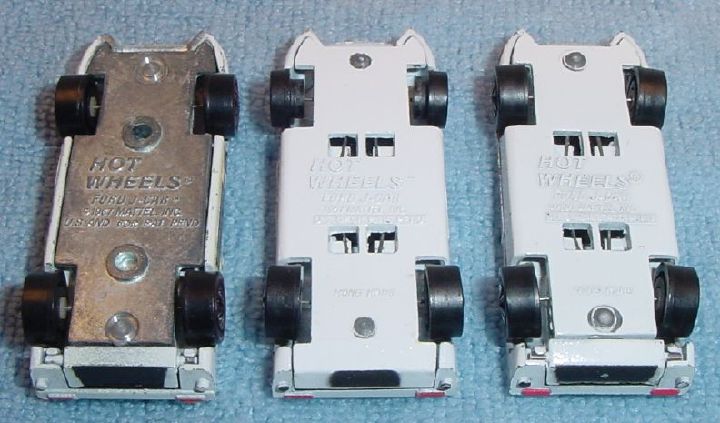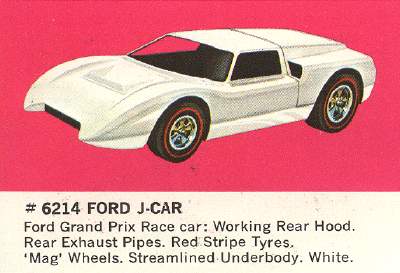

An
interesting Ford
J-Car recently was discovered by a collector while rumaging through a
box of old "beaters". Based on a number of features, J-Car
collectors believe that this car may represent a very interesting
prototype that appears to bridge the gap between the HK and US
castings. Currently, there is no provenance on this piece to
explain where (if at all) it fits into the design and production
history of the Hot Wheels Ford J-Car. It did not come from an
ex-Mattel employee nor is there any available documentation to explain
the existence of this car. However, a survey of some of the
features present on this car suggests an interesting story!

First,
a little background... A
key difference between HK and US Ford J-Cars is the base. HK cars
(which were in production earlier than US cars) feature a painted base
that turns up on the sides to form the "rocker panels" between the
front and rear wheels. US cars were made with a flat unpainted
base; the rocker panels are part of the body rather than part of the
base.

Base comparison: a US Ford J-Car (L), an early-run "hidden hinge" HK
J-Car (C), a common HK J-Car (R).
As
a result of this design difference, HK J-Cars often have a small gap at
the
mid-line where the base and body parts come together.

A side
view of US (L) and HK (R) red J-Cars.
J-Car
collectors have often wondered why there was such a difference in the
HK and US castings.
As mentioned above and on the Ford
J-Car page, the HK casting went into
production earlier than the US version. However, most later
run J-Cars seem to be US cars. Nearly all J-Cars found in 1969
"Grand Prix" series blister packs are the US casting.

So
why the different designs? The Mattel 1968 Collector's Catalog
describes a "streamlined underbody" as one of the features of the Ford
J-Car. Presumably, this refers to the integrated two-part body
design of the HK casting, wherein both parts were painted the same
color. Was the two-part body originally planned for US production
and then abandoned for some reason, in favor of a casting that employed
a flat unpainted base? And was HK production of the J-Car phased
out relatively early in favor of exclusively producing the US version?
We
can only speculate. And the recently discovered J-Car "proto"
serves to add fuel to the speculation!
Viewed
from the top, the car is immediately interesting because of the
off-white interior (production J-Cars feature black or tan interiors)
and the lack of casting details such as door and headlight lines,
vents, and the roof-mounted "periscope". The body appears to have
once been painted in an off-white enamel. The wheels are US-style
small size.

However,
the most interesting part of this car is the base. The car
features a base with US-style text and peg holes, but cast with
HK-style integrated rocker panels!

Viewed
from the side, the design is clearly in sync with the two-part HK
casting.


